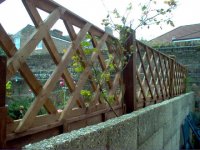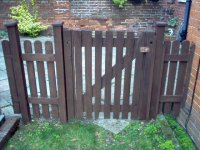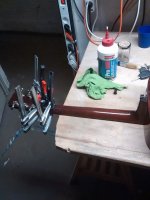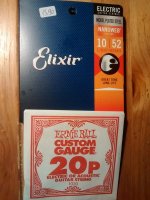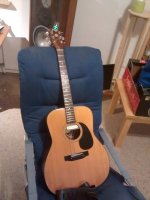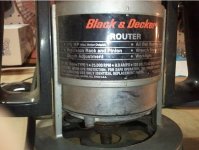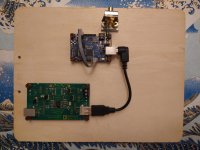Fixed the shower unit in the en suite bathroom.
One of the seals on the water inlet valve had decided to leak with a hissing.
replaced with a spare unit.
One of the seals on the water inlet valve had decided to leak with a hissing.
replaced with a spare unit.
Hope you used new washers. My cheapskate Landlord's efforts always leak like sieve after a week. Uses old ones and silicone sealant. 😕
Lot of paint in that tin. Touched up neighbour Paul's poor efforts at our common fence painting, which he had only done because of my nagging, and my insistence he was reducing the value of all our properties by letting things slide into the slum category.
Patio Gate was looking a bit tatty too. Can't think of anything else to paint. Greenhouse needs sorting next.
Lot of paint in that tin. Touched up neighbour Paul's poor efforts at our common fence painting, which he had only done because of my nagging, and my insistence he was reducing the value of all our properties by letting things slide into the slum category.
Patio Gate was looking a bit tatty too. Can't think of anything else to paint. Greenhouse needs sorting next.
Attachments
My beloved acoustic guitar I bought about 1972 was on the bench. This old lady served me for about 50yrs and I may have stressed her a bit too much during this corona era. Eventually she encountered a breakdown, dropped to the ground and broke her neck. Immediately I took her to next emergency station in the cellar. Applied glue on both sides of the fracture. Smoothed it with a paintbrush then heavily pressed using 3 clamps. About 8 hours later I removed the clamps. The healing process looks nearly seamless. I allowed 1 day for convalescence and in the meantime bought some strings. Now I have set up the strings and will check her on the next band rehearsal this evening.
Attachments
Not audio but still electronics.
A side project has been a model railway DCC power booster.
It takes in DCC signals from a main controller and puts out a signal up to 1.6 amps to a secondary track with or without DCC accessories.
The input is an opto coupler into a PIC32mx micro.
The micro then copies signal phase split to an H bridge to get plus and minus phases of signal. It does get a bit more complicated in that it must also check for an overload and turn off H bridge if it sees one and light an LED.
Powered it up and overload LED came on.
Looked at output and glitches on it.
So looks like shoot through on the H bridge.
Tweaked software dead time on H bridge and that improved it.
Now dropping out even on light loads.
The overload circuit does have a cap on it but was still catching glitches and outputting overload status of true.
So back into the software and after changing phase of H bridge I have a delay to get past the glitch before looking at OVERLOAD and that sorted it.
A side project has been a model railway DCC power booster.
It takes in DCC signals from a main controller and puts out a signal up to 1.6 amps to a secondary track with or without DCC accessories.
The input is an opto coupler into a PIC32mx micro.
The micro then copies signal phase split to an H bridge to get plus and minus phases of signal. It does get a bit more complicated in that it must also check for an overload and turn off H bridge if it sees one and light an LED.
Powered it up and overload LED came on.
Looked at output and glitches on it.
So looks like shoot through on the H bridge.
Tweaked software dead time on H bridge and that improved it.
Now dropping out even on light loads.
The overload circuit does have a cap on it but was still catching glitches and outputting overload status of true.
So back into the software and after changing phase of H bridge I have a delay to get past the glitch before looking at OVERLOAD and that sorted it.
My beloved acoustic guitar
I had a disabled friend who played in a band.
He had a very expensive guitar.
One night at a gig during interval an elderly lady tripped and fell on his guitar snapping the guitar neck.
Luckily he made guitars himself from scratch and managed to fix it ok.
Had to do some repair to my Black & Decker router tonight.
I had planned to use it today, but it wouldn't kick on, I thought it was the trigger switch.
But it wasn't - apparently the brush housings have a projecting pin that presses into a receptacle down in the housing.
I would have preferred a design that is more solid and secure, but managed to clean and slightly bend the pins for a solid contact.
She reads 5 to 8 ohms now with the switch locked on, instead of 180+ to meg ohms.
It'll get a workout tommorrow, I want to use a 3/4" roundover bit to round the edges of a table radio cabinet that I am making.
I had planned to use it today, but it wouldn't kick on, I thought it was the trigger switch.
But it wasn't - apparently the brush housings have a projecting pin that presses into a receptacle down in the housing.
I would have preferred a design that is more solid and secure, but managed to clean and slightly bend the pins for a solid contact.
She reads 5 to 8 ohms now with the switch locked on, instead of 180+ to meg ohms.
It'll get a workout tommorrow, I want to use a 3/4" roundover bit to round the edges of a table radio cabinet that I am making.
Attachments
I fixed yet another piece of broadcast audio equipment that had a bad switch mode power supply. This in a card cage for an audio point to point distribution system that had started life as a T1 multiplexer but got converted to an audio over IP system. It costs over $600 to buy the new power supply card from the manufacturer but I can find the same core PS module and mount it to the card for about $55. I used to have to take a crack at repairing the SMPS in gear but these days they are commodities and easy to get most of the time.
I had an FM broadcast HD transmitter go off the air not long ago because the device that formats the audio for use by the transmitter used a $7 switch mode power supply from a far away place known for being cheap and cutting corners. And of course it failed. This is from the same manufacturer that will charge $600 for the other power supply card that I mentioned.
NOW A RANT about switch mode power supplies.
So the understanding is that these power supplies are more efficient than linear power supplies and that is the justification for the proliferation. But are they really more efficient in the big scale of things when you have to throw them away regularly. So we make them again and dispose of them again and we pretend that there is still a net gain in overall efficiency?
NEXT RANT ISSUE is the soft failure mode of these.
The power supply gradually emits greater and greater amounts of high frequency noise into the equipment as the electrolytic capacitors age. This does affect the sound quality of broadcast audio systems but people in the broadcasting industry don't realize it as the changes are gradual and there are so many other things in the signal path that trash the audio too. These power supplies are under designed and the manufacturers of equipment don't compensate for this. A big bank of capacitors and other filters designed into equipment downstream of switch mode power supplies make a world of improvement even in an as new device and also add a buffer against degradation of the SMPS.
I could add about the noise from a SMPS going back into your AC power lines and how that screws with other things but I'll stop for now.
I had an FM broadcast HD transmitter go off the air not long ago because the device that formats the audio for use by the transmitter used a $7 switch mode power supply from a far away place known for being cheap and cutting corners. And of course it failed. This is from the same manufacturer that will charge $600 for the other power supply card that I mentioned.
NOW A RANT about switch mode power supplies.
So the understanding is that these power supplies are more efficient than linear power supplies and that is the justification for the proliferation. But are they really more efficient in the big scale of things when you have to throw them away regularly. So we make them again and dispose of them again and we pretend that there is still a net gain in overall efficiency?
NEXT RANT ISSUE is the soft failure mode of these.
The power supply gradually emits greater and greater amounts of high frequency noise into the equipment as the electrolytic capacitors age. This does affect the sound quality of broadcast audio systems but people in the broadcasting industry don't realize it as the changes are gradual and there are so many other things in the signal path that trash the audio too. These power supplies are under designed and the manufacturers of equipment don't compensate for this. A big bank of capacitors and other filters designed into equipment downstream of switch mode power supplies make a world of improvement even in an as new device and also add a buffer against degradation of the SMPS.
I could add about the noise from a SMPS going back into your AC power lines and how that screws with other things but I'll stop for now.
NOW A RANT about switch mode power supplies.
So the understanding is that these power supplies are more efficient than linear power supplies and that is the justification for the proliferation. But are they really more efficient in the big scale of things when you have to throw them away regularly. So we make them again and dispose of them again and we pretend that there is still a net gain in overall efficiency?
I could add about the noise from a SMPS going back into your AC power lines and how that screws with other things but I'll stop for now.
I never liked SMPS..... I don't care who or what thinks about them, I don't like them.
Give me a good old linear supply any old day.
Much more reliable and quiet.
Harris Intraplex?...an audio point to point distribution system that had started life as a T1 multiplexer but got converted to an audio over IP system....
Switching supplies don't bother me as much as custom 'use every device in the catalogue' custom analogue designs from manufacturers like McCurdy.
You can buy SMPS that are VERY reliable. Yes, you have to PAY for them. Pay, pay, PAY.
In this day and age of cheap, the 60 Hz transformer wins concerning durability. Even a modestly priced one like Antek isn’t going to die on you, or tell you to go **** yourself (and turn itself off) when you draw three times it’s rating for a few seconds at a time. And contrary to popular belief, they are extremely efficient - operating without fans.
In this day and age of cheap, the 60 Hz transformer wins concerning durability. Even a modestly priced one like Antek isn’t going to die on you, or tell you to go **** yourself (and turn itself off) when you draw three times it’s rating for a few seconds at a time. And contrary to popular belief, they are extremely efficient - operating without fans.
Harris Intraplex?
Switching supplies don't bother me as much as custom 'use every device in the catalogue' custom analogue designs from manufacturers like McCurdy.
Yup, Harris Intraplex and the CM-30 card that replaced the CM-5 card T-1 interface. They found a way to put TDMA frames into ethernet. Loads of overhead but better than having to buy a new platform.
Back in the day when I could control most things in the audio path at radio stations I would build a pair of card cage boards for the Intraplexes that were only capacitor boards. Electrolytic and film caps across all of the supply voltages. Listening to the station from a good monitoring point and having someone pull the capacitor boards out one at a time was a good reward because the capacitor boards really helped the quality of the audio and it was noticeable when they went away.
I bought some thick washers at the local HW store, drilled them out, welded them to the upper hinge of the drivers side car door to my granddaughters GMC Jimmy, and drove a bolt through it to temporarily repair it until I can take it to a body shop to replace the hinges.
Kind of a kluge, but the hinge pin dropped out and the door was ajar and dangerous in my opinion.
Kind of a kluge, but the hinge pin dropped out and the door was ajar and dangerous in my opinion.
You can buy SMPS that are VERY reliable. Yes, you have to PAY for them. Pay, pay, PAY.
In this day and age of cheap, the 60 Hz transformer wins concerning durability. Even a modestly priced one like Antek isn’t going to die on you, or tell you to go **** yourself (and turn itself off) when you draw three times it’s rating for a few seconds at a time. And contrary to popular belief, they are extremely efficient - operating without fans.
Agreed!
I could add about the noise from a SMPS going back into your AC power lines and how that screws with other things but I'll stop for now.
Many people totally ignore this. Some people think that adding a post supply Reg, everything is solved. The variety of noises spreads everywhere.
I did a fair amount of work to filter and isolate a USB DAC. Required a lot of filtering everywhere, and even then, in the end, this was not as good as using a Linear Regulated PSU.
Tonight I spent some "quality" time with an ancient Peavey 1.3K power amp on the bench that's been giving me fits. Nearly every time I've tried to sit down with it, it's behaved differently from the time before. Frustrating.
Like many amps from the period, this one uses grounded-emitter output & driver stages. I've always had a bit of a mental block with these; everything seems inside-out. I've tried to envision the supply rails bouncing around with the audio (which basically is exactly what's happening, sort of), but that imagery is only partially helpful to me.
When it comes to simple troubleshooting of these circuits with a voltmeter, I've settled in on the trick of attaching the meter's negative lead to the positive speaker terminal (which is connected to the supply "common" in this case). This makes the voltage relationships appear normal again, if that makes any sense. Using this method I was able to find the main problem fairly quickly - a very loose quick-connect terminal on one of the power transformer leads! Yes, that will indeed cause any number of intermittent / weird symptoms, heh.
Of course the above trick only works with a battery-operated voltmeter; anything with a 3-wire power cord, such as a scope, would require a differential measurement.
Does anyone else out there have a problem "seeing" these grounded-emitter circuits, or is it just me? 🙁
Like many amps from the period, this one uses grounded-emitter output & driver stages. I've always had a bit of a mental block with these; everything seems inside-out. I've tried to envision the supply rails bouncing around with the audio (which basically is exactly what's happening, sort of), but that imagery is only partially helpful to me.
When it comes to simple troubleshooting of these circuits with a voltmeter, I've settled in on the trick of attaching the meter's negative lead to the positive speaker terminal (which is connected to the supply "common" in this case). This makes the voltage relationships appear normal again, if that makes any sense. Using this method I was able to find the main problem fairly quickly - a very loose quick-connect terminal on one of the power transformer leads! Yes, that will indeed cause any number of intermittent / weird symptoms, heh.
Of course the above trick only works with a battery-operated voltmeter; anything with a 3-wire power cord, such as a scope, would require a differential measurement.
Does anyone else out there have a problem "seeing" these grounded-emitter circuits, or is it just me? 🙁
I could add about the noise from a SMPS going back into your AC power lines and how that screws with other things but I'll stop for now.
Many people totally ignore this. Some people think that adding a post supply Reg, everything is solved. The variety of noises spreads everywhere.
I have chased down strange noise on my line voltage, and even on "ground."
On one occasion the ground was noisy due to an open ground wire on a MeanWell SMPS. That let the nasty stuff back into the power lines.
I spent several days chasing some random bursts of high frequency noise on the output of a freshly built tube amp. It became obvious when I turned the overhead LED shop lights off to take a picture of the stored image on my scope screen and the amp's THD improved. Yes, the Walmart LED shop lights are nice and bright, but radiate 30 KHz crud like a radio frequency jamming device. I have learned to turn them off for any critical audio measurement.
Many people totally ignore this. Some people think that adding a post supply Reg, everything is solved. The variety of noises spreads everywhere.
I did a fair amount of work to filter and isolate a USB DAC. Required a lot of filtering everywhere, and even then, in the end, this was not as good as using a Linear Regulated PSU.
Hi YashN. I've been dealing with USB isolation myself. I have a DAC that I love but it only has SPDIF and AES digital inputs. I bought a USB to SPDIF converter board that had a toggle switch to toggle between an external +5 Volt supply and the power derived from the USB's +5 Volts. The differences in listening between the external supply and the USB were very significant. Also having the laptop charger connected to or off of the MacBook was a noticeable difference when using USB power (off was better).
That experience got me on the path to finding the best solution for USB as a source. I bought Analog Devices' ADUM4160 evaluation board which galvanically isolates the usb path between ends. It allows separate +5 Volt supply inputs on each side of it. I also bought another USB to SPDIF converter that has its own isolation and separate +5 Volt supply inputs at each end too. I will be powering these devices with four LT3045 voltage regulators and linear power supplies. I hope to get it all mounted into a nice chassis of its own.
The ADUM4160 evaluation board is interesting and even gives you a spot to solder in common mode chokes for the USB signal. As sold that is jumpered to bypass that socket.
The picture shows the two boards as I get ready for a test build with external power supplies.
Attachments
I got caught out when finding noise in a new design amp.
It had about 20KHz noise everywhere.
My bench light is about 6 inches above the pcb and was radiating into it.
In the 1980's I remember working on an analogue modem.
It was picking up 50Hz.
Power supply was fine so wasnt from there.
Then my boss came in and asked why I had the sig gen on top of the scope.
I said because its handy there.
He said there is a mains transformer in the sig gen radiating into the scope.
It had about 20KHz noise everywhere.
My bench light is about 6 inches above the pcb and was radiating into it.
In the 1980's I remember working on an analogue modem.
It was picking up 50Hz.
Power supply was fine so wasnt from there.
Then my boss came in and asked why I had the sig gen on top of the scope.
I said because its handy there.
He said there is a mains transformer in the sig gen radiating into the scope.
Yes, the Walmart LED shop lights are nice and bright, but radiate 30 KHz crud like a radio frequency jamming device. I have learned to turn them off for any critical audio measurement.
I was chasing down a 50 kHZ “oscillation” in a power amp for about a week. The oscillations only occurred with the volume pot turned all the way down, and followed that one amplifier around. Another being built at the same time was clean so it had to be the amp, right? Wrong. Turn off the lights and the “oscillation” was *gone*.
- Home
- Member Areas
- The Lounge
- What did you last repair?
